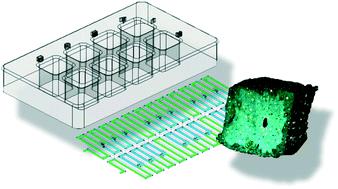Our official English website, www.x-mol.net, welcomes your feedback! (Note: you will need to create a separate account there.)
Microdissected “cuboids” for microfluidic drug testing of intact tissues
Lab on a Chip ( IF 6.1 ) Pub Date : 2020-11-11 , DOI: 10.1039/d0lc00801j Lisa F Horowitz 1 , Adan D Rodriguez , Allan Au-Yeung , Kevin W Bishop , Lindsey A Barner , Gargi Mishra , Aashik Raman , Priscilla Delgado , Jonathan T C Liu , Taranjit S Gujral , Mehdi Mehrabi , Mengsu Yang , Robert H Pierce , Albert Folch
Lab on a Chip ( IF 6.1 ) Pub Date : 2020-11-11 , DOI: 10.1039/d0lc00801j Lisa F Horowitz 1 , Adan D Rodriguez , Allan Au-Yeung , Kevin W Bishop , Lindsey A Barner , Gargi Mishra , Aashik Raman , Priscilla Delgado , Jonathan T C Liu , Taranjit S Gujral , Mehdi Mehrabi , Mengsu Yang , Robert H Pierce , Albert Folch
Affiliation

|
As preclinical animal tests often do not accurately predict drug effects later observed in humans, most drugs under development fail to reach the market. Thus there is a critical need for functional drug testing platforms that use human, intact tissues to complement animal studies. To enable future multiplexed delivery of many drugs to one small biopsy, we have developed a multi-well microfluidic platform that selectively treats cuboidal-shaped microdissected tissues or “cuboids” with well-preserved tissue microenvironments. We create large numbers of uniformly-sized cuboids by semi-automated sectioning of tissue with a commercially available tissue chopper. Here we demonstrate the microdissection method on normal mouse liver, which we characterize with quantitative 3D imaging, and on human glioma xenograft tumors, which we evaluate after time in culture for viability and preservation of the microenvironment. The benefits of size uniformity include lower heterogeneity in future biological assays as well as facilitation of their physical manipulation by automation. Our prototype platform consists of a microfluidic circuit whose hydrodynamic traps immobilize the live cuboids in arrays at the bottom of a multi-well plate. Fluid dynamics simulations enabled the rapid evaluation of design alternatives and operational parameters. We demonstrate the proof-of-concept application of model soluble compounds such as dyes (CellTracker, Hoechst) and the cancer drug cisplatin. Upscaling of the microfluidic platform and microdissection method to larger arrays and numbers of cuboids could lead to direct testing of human tissues at high throughput, and thus could have a significant impact on drug discovery and personalized medicine.
中文翻译:

用于完整组织微流体药物测试的显微解剖“长方体”
由于临床前动物试验通常无法准确预测随后在人体中观察到的药物效果,因此大多数正在开发的药物未能进入市场。因此,迫切需要使用人体完整组织来补充动物研究的功能性药物测试平台。为了使未来能够将多种药物多重输送到一个小活检中,我们开发了一种多孔微流体平台,可以选择性地处理具有保存完好的组织微环境的立方形显微解剖组织或“长方体”。我们通过使用市售的组织切碎器对组织进行半自动切片来创建大量尺寸均匀的长方体。在这里,我们展示了对正常小鼠肝脏的显微解剖方法,我们通过定量 3D 成像来表征,以及对人神经胶质瘤异种移植肿瘤的显微解剖方法,我们在培养一段时间后评估其活力和微环境的保存。尺寸均匀性的好处包括未来生物测定中较低的异质性以及通过自动化促进其物理操作。我们的原型平台由微流体回路组成,其流体动力学陷阱将活长方体固定在多孔板底部的阵列中。流体动力学模拟可以快速评估设计方案和操作参数。我们展示了模型可溶性化合物(例如染料(CellTracker、Hoechst)和癌症药物顺铂)的概念验证应用。将微流控平台和显微切割方法升级到更大的阵列和更多的长方体可以以高通量直接测试人体组织,从而可能对药物发现和个性化医疗产生重大影响。
更新日期:2020-12-10
中文翻译:

用于完整组织微流体药物测试的显微解剖“长方体”
由于临床前动物试验通常无法准确预测随后在人体中观察到的药物效果,因此大多数正在开发的药物未能进入市场。因此,迫切需要使用人体完整组织来补充动物研究的功能性药物测试平台。为了使未来能够将多种药物多重输送到一个小活检中,我们开发了一种多孔微流体平台,可以选择性地处理具有保存完好的组织微环境的立方形显微解剖组织或“长方体”。我们通过使用市售的组织切碎器对组织进行半自动切片来创建大量尺寸均匀的长方体。在这里,我们展示了对正常小鼠肝脏的显微解剖方法,我们通过定量 3D 成像来表征,以及对人神经胶质瘤异种移植肿瘤的显微解剖方法,我们在培养一段时间后评估其活力和微环境的保存。尺寸均匀性的好处包括未来生物测定中较低的异质性以及通过自动化促进其物理操作。我们的原型平台由微流体回路组成,其流体动力学陷阱将活长方体固定在多孔板底部的阵列中。流体动力学模拟可以快速评估设计方案和操作参数。我们展示了模型可溶性化合物(例如染料(CellTracker、Hoechst)和癌症药物顺铂)的概念验证应用。将微流控平台和显微切割方法升级到更大的阵列和更多的长方体可以以高通量直接测试人体组织,从而可能对药物发现和个性化医疗产生重大影响。


























 京公网安备 11010802027423号
京公网安备 11010802027423号